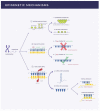Novel Concepts in Systemic Sclerosis Pathogenesis: Role for miRNAs
- PMID: 34680587
- PMCID: PMC8533248
- DOI: 10.3390/biomedicines9101471
Novel Concepts in Systemic Sclerosis Pathogenesis: Role for miRNAs
Abstract
Systemic sclerosis (SSc) is a rare connective tissue disease with heterogeneous clinical phenotypes. It is characterized by the pathogenic triad: microangiopathy, immune dysfunction, and fibrosis. Epigenetic mechanisms modulate gene expression without interfering with the DNA sequence. Epigenetic marks may be reversible and their differential response to external stimuli could explain the protean clinical manifestations of SSc while offering the opportunity of targeted drug development. Small, non-coding RNA sequences (miRNAs) have demonstrated complex interactions between vasculature, immune activation, and extracellular matrices. Distinct miRNA profiles were identified in SSc skin specimens and blood samples containing a wide variety of dysregulated miRNAs. Their target genes are mainly involved in profibrotic pathways, but new lines of evidence also confirm their participation in impaired angiogenesis and aberrant immune responses. Research approaches focusing on earlier stages of the disease and on differential miRNA expression in various tissues could bring novel insights into SSc pathogenesis and validate the clinical utility of miRNAs as biomarkers and therapeutic targets.
Keywords: epigenetic mechanisms; miRNAs; pathogenesis; systemic sclerosis.
Conflict of interest statement
The authors declare no conflict of interest.
Figures


References
-
- Leroy E.C., Black C., Fleischmajer R., Jablonska S., Krieg T., Medsger T.A., Rowell N., Wollheim F. Scleroderma (systemic sclerosis): Classification, subsets and pathogenesis. J. Rheumatol. 1988;15:202–205. - PubMed
Publication types
Grants and funding
LinkOut - more resources
Full Text Sources

